What is an SQCDP/SQDCP Board?
An SQDCP board is a visual management tool, commonly used in manufacturing, that displays and tracks key performance indicators (KPIs) related to Safety, Quality, Cost, Delivery, and People. It helps teams identify issues, recognise opportunities for improvement, and guide operations towards achieving business goals.
Book Free Demo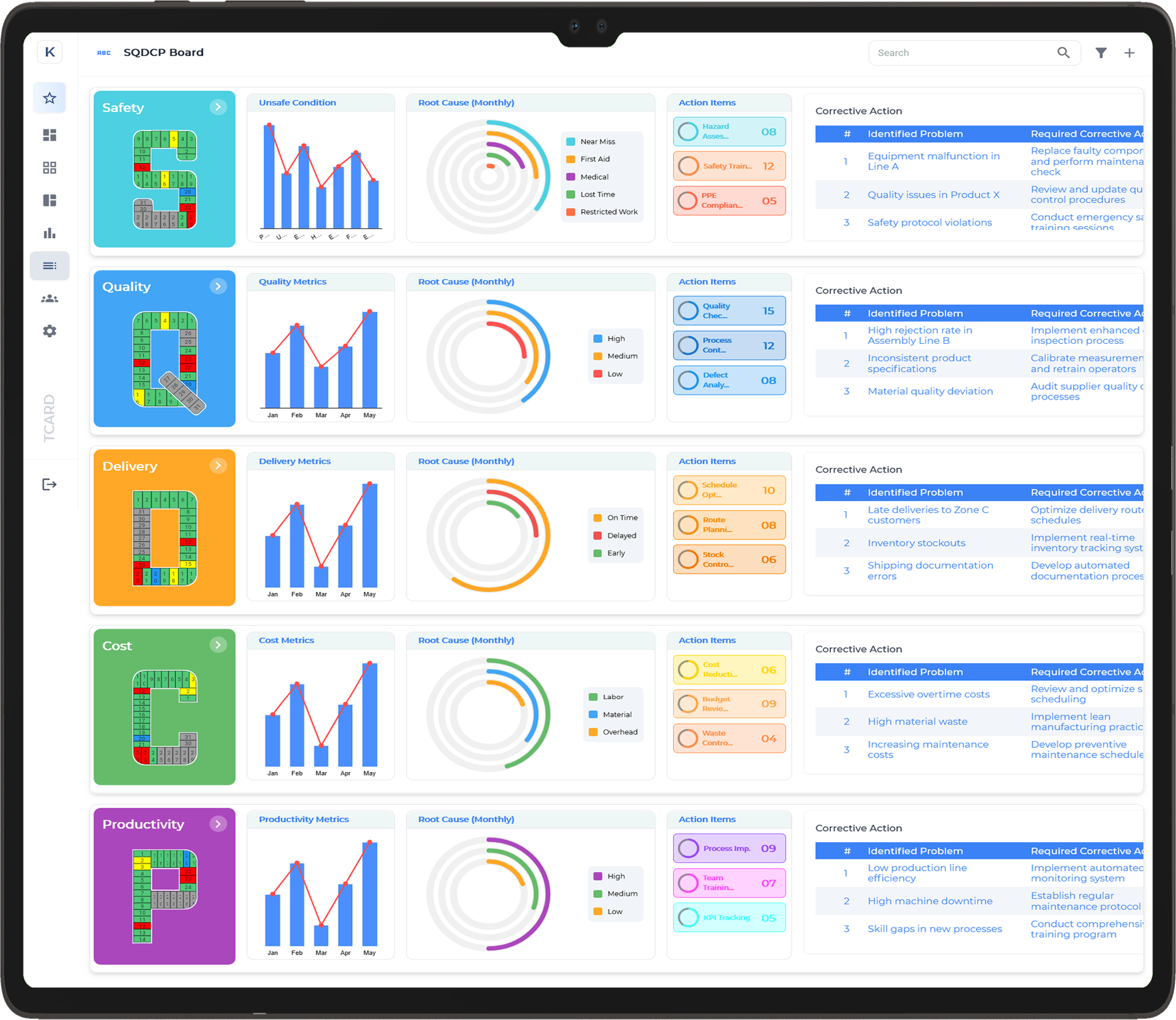
Safety
The Balanced Scorecard tracks accidents and records serious near-misses that occur onsite. It analyses health and safety data, providing a clear overview of safety measures and identifying areas that need further improvement.
- Accidents
- Near misses
- Safety incidents
- Safety talk
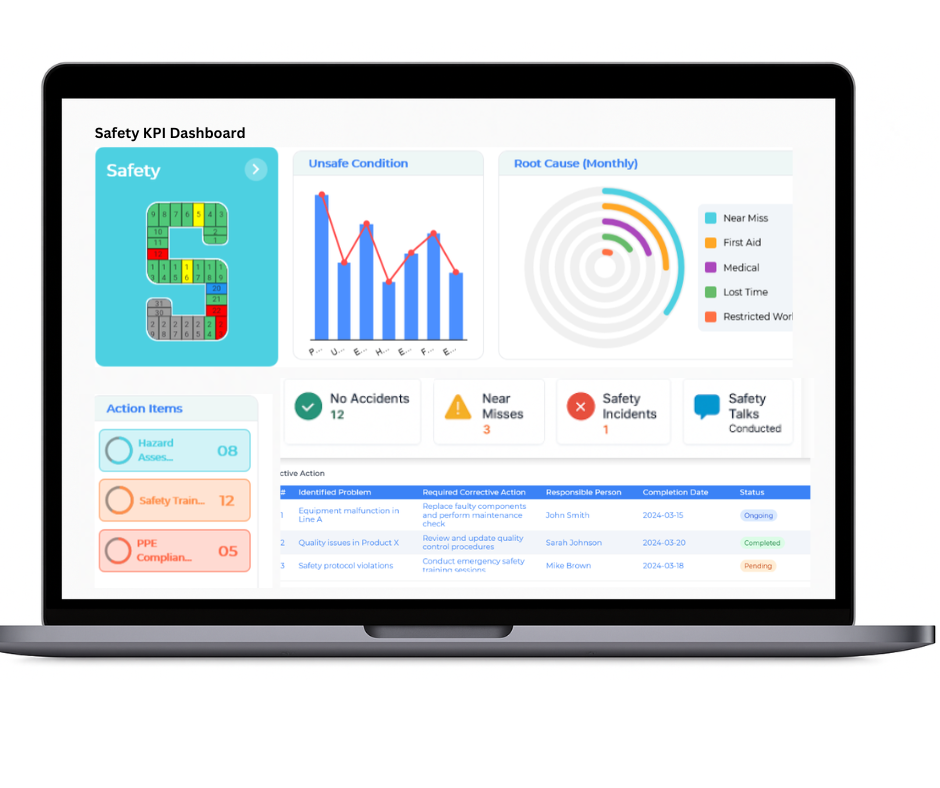
Quality
Quality metrics in the Balanced Scorecard help organisations measure the defect levels of both incoming and in-house products, as perceived and assessed by customers. By utilising these metrics, organisations can effectively manage and monitor quality-related processes.
- Accidents
- Number of the test fails
- Rework
- Non-conformance items
- Defects
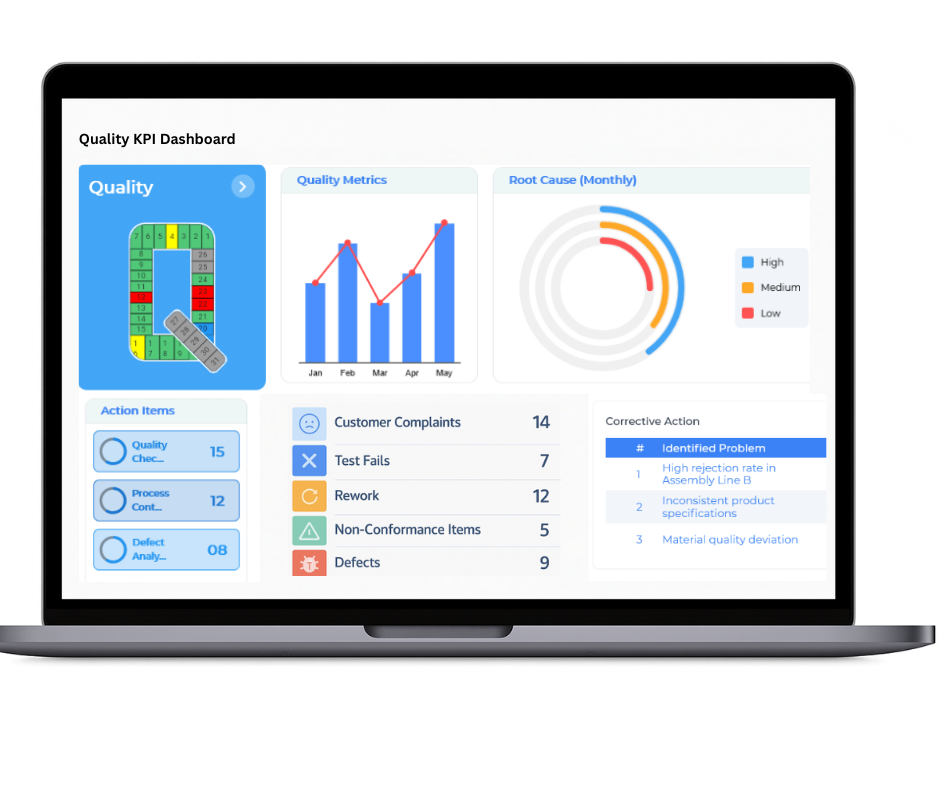
Delivery
The Balanced Scorecard monitors all delivery processes, ensuring OTIF (On Time In Full) performance from suppliers to customers. It analyses warehouse processes and stock movements, providing the management team with the relevant data for informed decision-making.
- Number of late deliveries
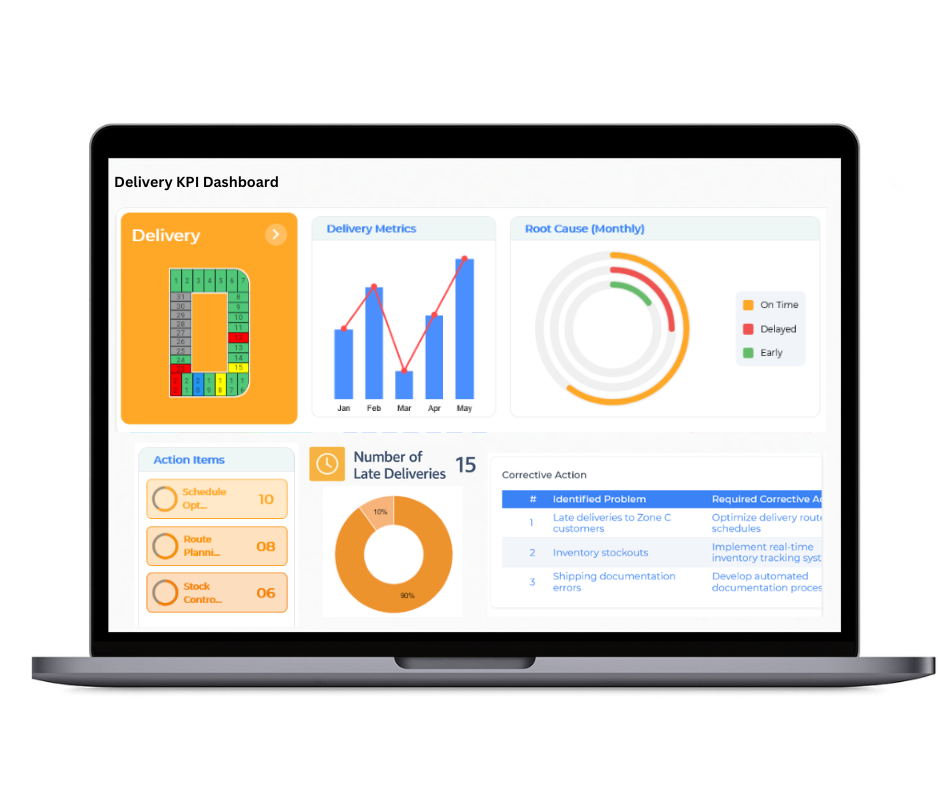
Cost
Financial goals and objectives are critical and sensitive metrics for any organisation. The Balanced Scorecard effectively manages financial objectives by analysing the organisation's financial data, providing comprehensive insights for better decision-making.
- Number of customer complaints
- Product Returns
- Feedback Trends

People
The people metrics in a Balanced Scorecard measure employees' performance in their job roles. By using a dynamic scorecard system, organisations can assess professional skills, training effectiveness, employees' understanding of organisational culture, teamwork, and alignment with company goals.
- Attendance and Absenteeism
- Training Hours Completed
- Employee Suggestions
- Engagement and Morale
- Team Performance
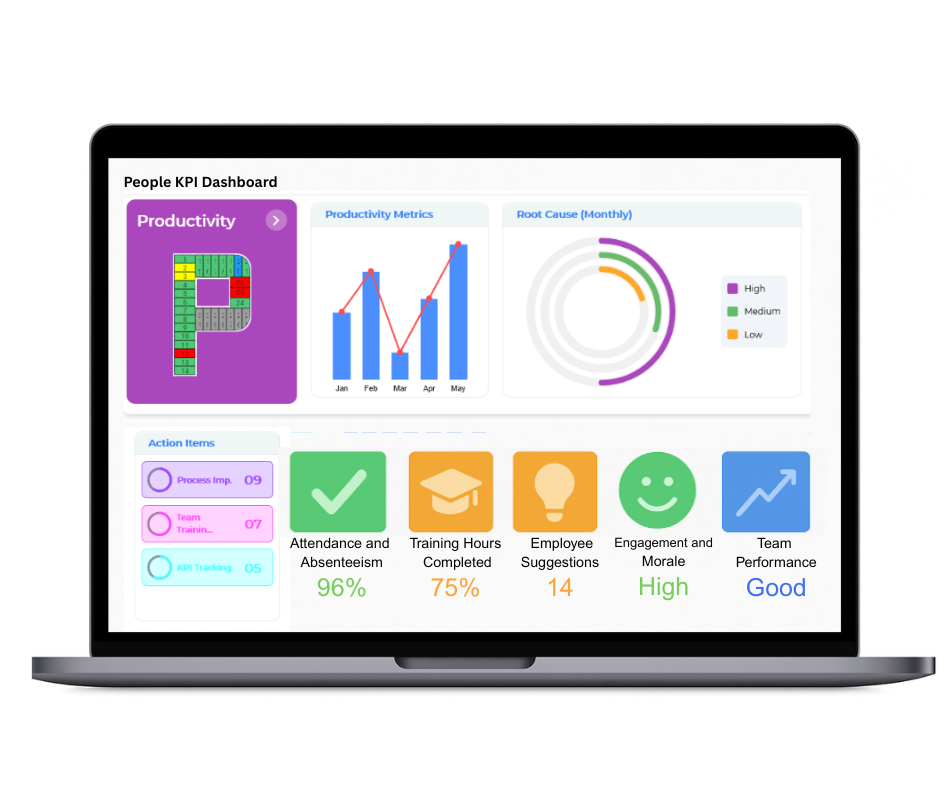
SQDCP Board for Shift Management
Real-Time Tracking: Monitors Safety, Quality, Delivery, Cost, and People metrics in real-time for each shift.
Improved Safety Monitoring: Logs accidents, near-misses, and safety checks to ensure a secure working environment.
Quality Control Per Shift: Tracks defects, rework, and adherence to quality standards during each shift.
Delivery Performance: Measures production output, OTIF (On Time In Full), and identifies process delays.
Cost Management: Monitors shift-wise resource usage, wastage, and operational costs.
People & Performance: Evaluates attendance, engagement, training, and shift team collaboration.
Quick Issue Escalation: Enables teams to flag issues immediately and take corrective action without delay.
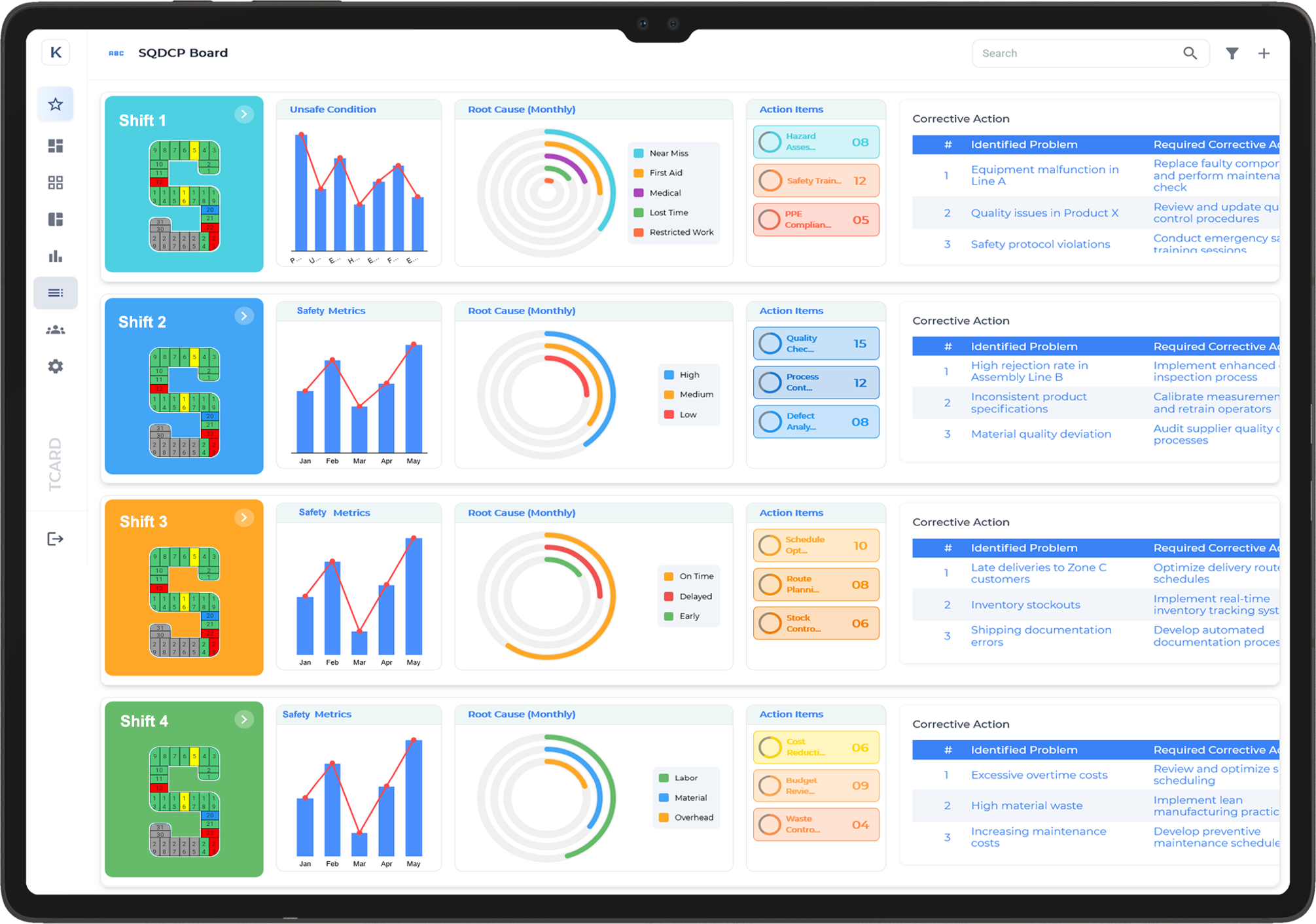
What Does SQDCP Stand For and Why It Matters in Modern Operations
SQDCP is a powerful operational tool used to monitor and improve performance across key areas of any business. The acronym stands for Safety, Quality, Delivery, Cost, and People. Each of these five pillars plays a crucial role in the daily running and long-term success of an organisation, especially in industries where performance, safety, and efficiency are vital.
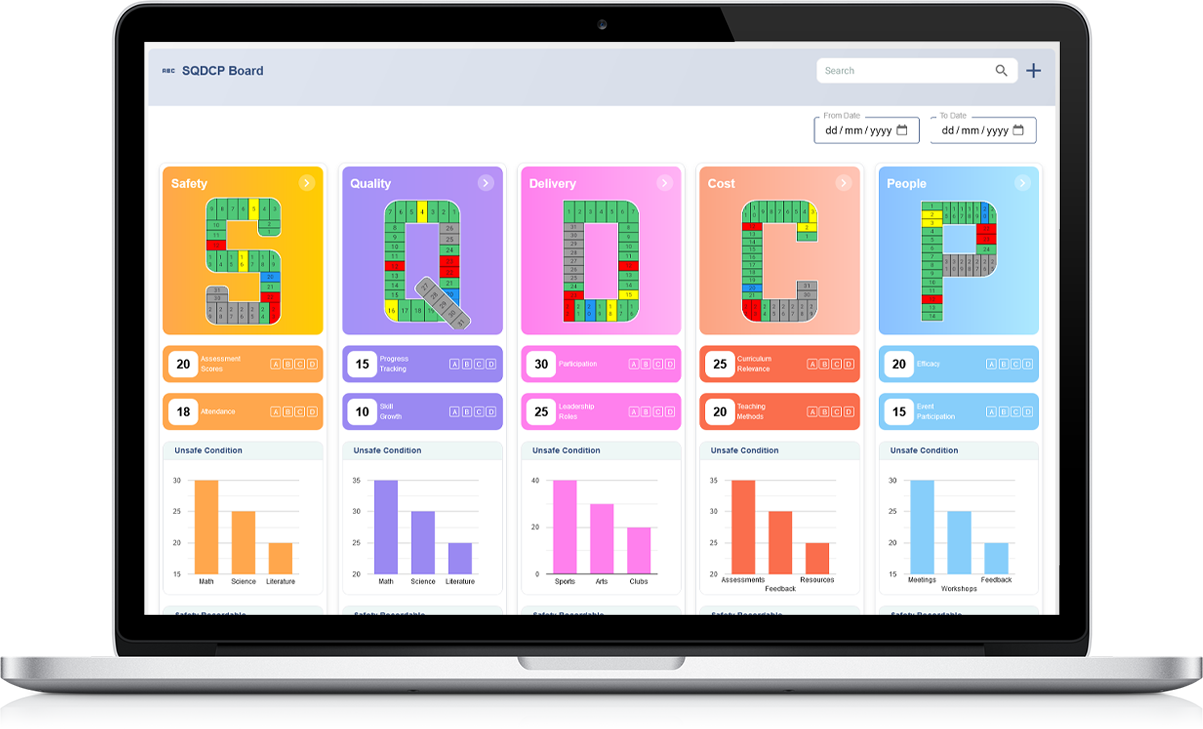
1. Safety
Safety is always the first priority. Monitoring workplace incidents, near misses, and hazards helps to maintain a safe environment for everyone. Keeping this front and centre ensures fewer disruptions and higher morale among team members.
2. Quality
Quality focuses on delivering work or products that meet required standards. Tracking defects, errors, or rework helps teams maintain consistency and reduce waste. High quality leads to satisfied clients and fewer issues in later stages.
3. Delivery
Delivery measures whether tasks or products are completed on time. This area ensures that the team stays on track and meets expectations, supporting customer satisfaction and operational flow.
4. Cost
Cost management focuses on controlling expenses, reducing waste, and making sure resources are used effectively. Good cost control leads to better financial performance and long-term growth.
5. People
This pillar covers employee engagement, attendance, training, and well-being. Supporting people leads to stronger teams, better collaboration, and improved outcomes.
SQDCP boards provide a visual and structured way to track these five pillars daily, helping teams stay focused, identify issues quickly, and drive continuous improvement in operations.
How SQDCP Boards Foster a Culture of Continuous Improvement
SQDCP boards are valuable tools that help organisations build and maintain a culture of continuous improvement. By focusing on five key pillars — Safety, Quality, Delivery, Cost, and People — these boards give teams a clear and consistent way to monitor performance and make steady progress each day.
Daily Visibility Drives Accountability
One of the main strengths of SQDCP boards is how they make performance visible. When teams can see daily updates and results in one place, they are more likely to take ownership of their actions. This visibility helps identify small issues before they grow into larger problems, encouraging daily action and learning.
Structured Problem Solving
Each section of the SQDCP board highlights areas that may need attention. Whether it's a safety concern, a missed delivery, or a drop in quality, teams can quickly note the issue and begin a structured approach to solving it. This regular problem-solving process forms the heart of continuous improvement.
Encourages Team Collaboration
Because SQDCP boards are often reviewed in team huddles or daily meetings, they promote open communication. Everyone contributes to tracking progress and suggesting improvements. This shared involvement helps build stronger teamwork and trust.
Supports Consistent Improvement Over Time
Rather than relying on one-off projects, SQDCP boards support steady, everyday improvements. Over time, these small wins lead to big results in performance, safety, and efficiency.
Breaking Down the Five Pillars of SQDCP: A Practical Overview
SQDCP stands for Safety, Quality, Delivery, Cost, and People — five core pillars used by organisations to monitor and improve their operations. Each element plays a vital role in supporting daily performance and long-term success. Understanding these areas helps teams focus their efforts and identify where improvements can be made.
Safety
Safety is always the top priority. This pillar focuses on maintaining a secure work environment, reducing risks, and preventing accidents. Teams monitor incidents and near misses to ensure everyone goes home safe each day.
Quality
The quality pillar tracks how well products or services meet expected standards. It highlights defects, rework, or customer complaints. Keeping quality high means fewer errors, more satisfied customers, and reduced waste.
Delivery
Delivery refers to whether tasks, services, or products are completed on time. This pillar measures schedule adherence, helping teams improve planning, reduce delays, and meet customer expectations more consistently.
Cost
This area focuses on efficient use of resources. Teams monitor waste, downtime, and other cost-related factors. The goal is to deliver value while keeping expenses under control, improving the bottom line over time.
People
The people pillar reflects workforce engagement and development. It tracks training, morale, and participation in improvement activities. Investing in people ensures that teams stay motivated, skilled, and involved in continuous growth.
Using SQDCP Boards for Daily Performance Tracking
SQDCP boards are practical tools used by organisations to monitor and manage daily operations across five key areas: Safety, Quality, Delivery, Cost, and People. These boards help teams visualise performance, identify issues early, and take quick action to improve overall results. By using them as part of daily routines, teams build strong habits around continuous improvement.
Tracking Safety
Each day, teams review safety indicators, such as incidents, near misses, or hazards. This helps keep safety top of mind and encourages a proactive approach to preventing accidents in the workplace.
Monitoring Quality
The quality section tracks product or service performance, defects, and errors. This allows teams to spot trends, reduce rework, and ensure that standards are being met consistently across all activities.
Reviewing Delivery
Delivery metrics focus on whether tasks or outputs are completed on time. By tracking delays or missed deadlines, teams can improve planning and execution, ensuring better customer satisfaction and smoother workflows.
Controlling Cost
Cost indicators highlight waste, resource usage, and other expenses. By reviewing this data regularly, teams can find ways to cut unnecessary costs and use materials more efficiently.
Engaging People
The people section measures participation, training, and engagement levels. It helps identify where support or development is needed, ensuring the team stays motivated and involved in continuous improvement.
How to Set Up an Effective SQDCP Board in Your Workplace
Setting up an SQDCP board in your workplace is a practical way to track and improve performance in key operational areas. SQDCP stands for Safety, Quality, Delivery, Cost, and People — five critical pillars that support efficient and sustainable operations. A well-organised board helps teams stay focused, encourages accountability, and promotes continuous improvement.
Choose the Right Location
Place your SQDCP board in a visible and accessible area where team members meet daily. This ensures that everyone can view updates and contribute to discussions during shift meetings or daily stand-ups.
Define Clear Metrics
Each category should have simple, easy-to-understand indicators. For example, Safety might track reported incidents, while Delivery could show orders completed on time. Use charts or colour-coded signals to highlight trends and problem areas.
Update the Board Regularly
Daily updates keep the board relevant and actionable. Assign team members to gather and record data consistently. This promotes shared responsibility and builds a culture of transparency and ownership.
Encourage Team Involvement
Engage your team by discussing what the board reveals. Celebrate positive trends and use red flags as opportunities to work together on improvements. Make the board a tool for communication, not just data display.
Review and Improve
Periodically assess how well your SQDCP board is working. Are the metrics useful? Is the team engaged? Adjust as needed to keep the board effective and aligned with your goals.
The Role of Visual Management in SQDCP Success
Visual management plays a key role in the success of SQDCP boards by making performance information clear, immediate, and easy to understand. It helps teams stay aligned with operational goals and respond quickly to any issues across the five key areas: Safety, Quality, Delivery, Cost, and People.
Making Performance Visible
With visual tools like colour-coded charts, symbols, and graphs, team members can instantly see how each area is performing. This reduces the need for long explanations or reports, saving time and helping everyone focus on what matters most.
Promoting Quick Decision-Making
Visual cues allow managers and teams to spot problems at a glance. For example, a red mark in the Safety section signals an incident that needs urgent attention. This immediate visibility supports faster problem-solving and encourages accountability.
Improving Daily Communication
During daily meetings, the visual SQDCP board acts as a shared reference point. It helps structure discussions, keeps everyone on the same page, and ensures that no area is overlooked. This strengthens team coordination and focus.
Encouraging Engagement and Ownership
When team members see their actions reflected in the board's results, they become more invested in outcomes. Visual management turns performance into a shared responsibility, building a stronger culture of involvement and improvement.
Driving Continuous Improvement
By tracking trends over time with visual tools, teams can identify recurring issues and plan long-term solutions. This makes visual management an essential part of any workplace that values progress and operational excellence.

Tracking Safety Metrics Effectively with SQDCP Boards
Safety is a vital part of any successful operation, and SQDCP boards help ensure it remains a top priority. By giving teams a clear, visual method for tracking safety performance, these boards make it easier to stay on top of incidents, identify risks, and promote a culture of prevention.
Highlighting Key Safety Indicators
The Safety section of the SQDCP board focuses on important metrics such as reported incidents, near-misses, and daily checks. Displaying these figures clearly allows everyone to monitor trends and see whether safety standards are being met each day.
Supporting Immediate Action
When a safety issue arises, the board can quickly show that attention is needed. For instance, using colour-coded signals helps teams know which items are under control and which need review. This fast feedback loop helps prevent minor concerns from becoming serious problems.
Encouraging Team Awareness
By making safety data visible to all, SQDCP boards raise awareness across departments. Everyone can see their role in maintaining a safe work environment, which builds a stronger sense of responsibility and shared purpose.
Reviewing and Learning from Incidents
Boards also provide space to log past incidents and track corrective actions. Over time, this helps teams reflect on past challenges, learn from them, and put steps in place to avoid similar situations in the future.
Driving a Safety-First Culture
With consistent updates and clear communication, SQDCP boards turn safety from a background task into an everyday focus. They help make safety a visible, ongoing goal that supports the wellbeing of all team members.
Quality Checks Made Easy: How SQDCP Boards Help Spot Issues Early
Maintaining high quality standards is essential in any workplace. SQDCP boards make it easier for teams to monitor and improve quality by providing a clear, daily visual of performance. These boards help highlight problems early and guide teams in taking quick action before small issues become big ones.
Daily Focus on Quality
The Quality section of an SQDCP board is updated each day with results from inspections, tests, or process checks. This keeps everyone informed about how well standards are being met and where improvements may be needed.
Spotting Problems Early
One of the key benefits of using SQDCP boards is the ability to catch quality issues quickly. When results fall outside the expected range, they are marked clearly, making it easy for the team to notice and investigate. This early warning system helps reduce waste, rework, and customer complaints.
Encouraging Team Involvement
Quality is not just the job of one person or department. With an SQDCP board, everyone in the team can see how their work affects the final outcome. This shared visibility encourages people to take more care and speak up if they see something going wrong.
Driving Continuous Improvement
Over time, patterns in quality issues can be tracked on the board. Teams can use this information to adjust processes, train staff, or improve tools. This leads to long-term improvement and stronger product or service quality.
Reducing Downtime with Delivery Tracking on SQDCP Boards
Downtime can be costly for any organisation, especially in fast-paced operations. One effective way to minimise delays is by closely monitoring deliveries, and SQDCP boards make this process simple and visual. The Delivery section of an SQDCP board helps teams keep track of incoming and outgoing materials in real time, reducing the risk of production slowdowns.
Clear Tracking of Deliveries
Using the Delivery section, teams can record daily updates on whether materials or products have arrived on time. This visibility allows for quick decision-making if a delay is expected. If something doesn’t arrive as planned, it’s noted immediately, which helps everyone respond quickly and adjust priorities.
Improved Communication Across Teams
Delivery tracking on SQDCP boards keeps all departments in the loop. Whether it’s production, logistics, or purchasing, everyone can see the same status updates. This improves planning and helps avoid unexpected downtime due to missing parts or delayed shipments.
Reducing Bottlenecks and Idle Time
By identifying late or missing deliveries early, teams can take action before they impact workflow. Alternative plans, such as shifting tasks or sourcing locally, can be made on time. This proactive approach reduces idle time and keeps operations running smoothly.
Boosting Overall Efficiency
Over time, tracking delivery trends can help identify recurring issues with suppliers or internal processes. Teams can then work to improve these areas, which not only reduces downtime but also strengthens overall supply chain reliability.
Controlling Costs Using the ‘Cost’ Element of SQDCP Boards
Managing costs effectively is essential for any organisation aiming to improve performance and maintain profitability. The ‘Cost’ section of an SQDCP board offers a clear and simple way to monitor daily spending, waste, and cost-saving opportunities. This visual tool makes financial awareness part of everyday operations, helping teams stay focused on reducing unnecessary expenses.
Daily Monitoring of Cost Metrics
The Cost element on an SQDCP board tracks key financial indicators, such as material waste, overtime hours, and unplanned maintenance. By updating this information regularly, teams can quickly spot patterns and take immediate action to control rising costs.
Encouraging Cost-Conscious Decisions
When cost data is displayed clearly and updated daily, it encourages staff to think carefully about how they use resources. This leads to better decision-making, where teams are more likely to choose cost-efficient methods without compromising on quality or safety.
Reducing Waste and Overruns
Cost tracking helps highlight areas where waste is common—be it energy use, material loss, or excess labour. Once these issues are visible, it’s easier to introduce targeted solutions that cut down on waste and reduce overspending.
Supporting Long-Term Savings
Consistent use of the Cost section can lead to lasting improvements. Over time, it helps build a culture of cost awareness, where small daily changes add up to significant savings. By controlling costs effectively, teams help ensure the sustainability and financial health of their operations.
How SQDCP Supports Proactive People and Process Development
SQDCP boards play a valuable role in supporting both people and process development in the workplace. By offering a daily visual summary of key performance areas—Safety, Quality, Delivery, Cost, and People—they promote proactive thinking, early problem-solving, and ongoing improvement across all teams.
Encouraging Employee Engagement
The 'People' section of an SQDCP board encourages open communication and active involvement. It highlights areas such as training, attendance, team support, and employee feedback. This allows leaders to recognise gaps in knowledge, provide timely support, and invest in skill-building activities that benefit both the team and the business.
Driving Process Improvement
By regularly reviewing the full SQDCP board, teams can identify weak spots in daily operations. Whether it's a delay in delivery, a rise in defects, or safety concerns, this visibility prompts faster action and process reviews. As issues are addressed early, the risk of larger problems is reduced.
Promoting a Culture of Ownership
When everyone has access to clear performance data, team members feel more responsible for their area of work. SQDCP boards encourage ownership and accountability, helping staff not only react to problems but also contribute ideas for improvement.
Supporting Continuous Learning
As part of a broader improvement strategy, SQDCP boards act as learning tools. They highlight lessons from both successes and challenges, guiding teams toward smarter ways of working and stronger long-term performance.
Boosting Team Engagement Through SQDCP Visuals and Ownership
Visual tools like SQDCP boards can make a real difference when it comes to team engagement. By clearly displaying performance across key areas—Safety, Quality, Delivery, Cost, and People—these boards encourage open discussion, shared responsibility, and team-driven improvement every day.
Making Performance Easy to Understand
With simple colours and symbols, SQDCP visuals quickly show what’s going well and where support is needed. This makes it easier for all team members, regardless of their role, to understand daily goals and challenges without needing to read detailed reports or spreadsheets.
Encouraging Daily Involvement
Teams that use SQDCP boards regularly are more likely to speak up, share ideas, and take action. Visual updates invite participation, giving everyone the chance to contribute to problem-solving and performance improvement in real time.
Building a Sense of Ownership
When individuals see how their efforts directly impact team results, they become more committed to their roles. SQDCP boards support this by linking actions to outcomes, helping people feel valued and responsible for both successes and setbacks.
Creating a Positive Work Culture
Over time, the regular use of SQDCP visuals can help build a more open and proactive work culture. As teams get used to tracking and improving performance together, they develop stronger habits of communication, trust, and mutual support—boosting morale as well as results.
Digital vs Physical SQDCP Boards: Which One is Right for You?
When it comes to using SQDCP boards to track performance, teams often face the decision between using digital or physical boards. Both have their advantages and disadvantages, so it’s important to consider which option best suits your team’s needs.
Advantages of Physical SQDCP Boards
Physical boards are highly visual and can be more engaging for teams that work in a shared physical space. They provide a real-time overview of performance metrics like Safety, Quality, Delivery, Cost, and People, which is easy for everyone to see and interact with. The tactile nature of moving cards or markers can make it easier to track progress and encourage collaboration during daily meetings.
Benefits of Digital SQDCP Boards
On the other hand, digital SQDCP boards offer flexibility and scalability. They are ideal for remote teams or those with multiple locations, allowing team members to update and view metrics from anywhere. Digital boards can also integrate with other software tools, streamlining data collection and analysis. Additionally, digital boards offer the advantage of reducing physical clutter and making it easier to store and access historical data.
Which One is Right for You?
The choice between digital and physical SQDCP boards depends on your team's working environment and preferences. If your team works in one location and values hands-on interaction, a physical board might be ideal. However, if your team is dispersed or requires seamless integration with other tools, a digital board may be more suitable. Regardless of the format, the key is to ensure that the board encourages collaboration, transparency, and continuous improvement.
Using SQDCP Data to Drive Strategic Operational Decisions
In today’s fast-paced business world, leveraging data effectively is crucial for making informed decisions that drive operational success. SQDCP (Safety, Quality, Delivery, Cost, and People) boards provide a clear and visual representation of key performance indicators (KPIs) that can be used to steer strategic decisions and improve operational efficiency.
Harnessing Safety and Quality Data
Tracking safety and quality metrics using SQDCP boards helps identify areas of improvement in both workplace conditions and product standards. By reviewing these metrics regularly, managers can pinpoint recurring issues or potential hazards, enabling proactive measures to reduce incidents and enhance product quality. This data can inform training programmes, safety protocols, and quality control processes.
Optimising Delivery and Cost
Delivery performance is crucial to meeting customer expectations, while cost management ensures profitability. By monitoring delivery times and costs on SQDCP boards, teams can identify bottlenecks, inefficiencies, or areas where resources are being wasted. This data allows leaders to make data-driven decisions regarding supply chain optimisation, resource allocation, and cost-cutting strategies.
People-Related Insights for Better Team Management
Tracking people-related data, such as employee performance, engagement, and workload distribution, provides valuable insights into team dynamics. Using SQDCP boards to manage this information helps in identifying high-performing employees, recognising areas where additional support is needed, and promoting a healthier, more balanced work environment.
By using SQDCP data to inform decisions, organisations can create a culture of continuous improvement, ensuring that operations are both efficient and aligned with strategic goals.
Case Studies: How Leading Organisations Use SQDCP for Continuous Improvement
Leading organisations across various industries are increasingly adopting SQDCP boards to drive continuous improvement. The SQDCP framework — Safety, Quality, Delivery, Cost, and People — provides a comprehensive approach to monitor performance and foster a culture of ongoing development. Let’s explore a few case studies of organisations successfully using SQDCP boards to improve their operations.
Case Study 1: Manufacturing Industry
A large manufacturing company implemented SQDCP boards to streamline its operations and improve product quality. By tracking key metrics like defect rates, delivery times, and employee safety, the company identified recurring issues in its production line. By addressing these issues through targeted training and process changes, the company achieved a significant reduction in defects and improved delivery times, all while lowering operational costs.
Case Study 2: Retail Sector
A well-known retailer used SQDCP boards to improve customer service and inventory management. By focusing on delivery performance and cost, the company was able to optimise its supply chain, reduce stock-outs, and improve overall customer satisfaction. By tracking employee performance and engagement, they also increased team morale and reduced turnover, resulting in a more efficient and motivated workforce.
Case Study 3: Healthcare Industry
A healthcare provider utilised SQDCP boards to monitor the safety of patient care and enhance quality standards. Tracking incidents and patient satisfaction allowed them to identify gaps in service delivery. As a result, they implemented changes in staffing and training that improved patient outcomes, decreased wait times, and enhanced the overall patient experience.
These case studies demonstrate the power of SQDCP boards in driving continuous improvement across various sectors, proving their versatility and effectiveness in improving safety, quality, cost, delivery, and people management.
How Does the SQDCP Board Drive Continuous Improvement?
The SQDCP board is a powerful tool for driving continuous improvement in organisations by offering a clear, visual framework for tracking and enhancing performance across five critical areas: Safety, Quality, Delivery, Cost, and People. By focusing on these elements, the board helps organisations identify weaknesses, implement improvements, and optimise workflows on a day-to-day basis.
Safety
Tracking safety metrics is essential for maintaining a safe working environment. The SQDCP board helps identify safety risks early, allowing teams to implement corrective actions before accidents occur. Regular safety checks and updates foster a proactive safety culture, reducing the likelihood of workplace injuries and incidents.
Quality
Quality is a cornerstone of any organisation's success. The SQDCP board enables teams to monitor product or service quality in real-time, making it easier to spot trends, detect issues, and implement immediate corrective measures. By maintaining a focus on quality, organisations can improve customer satisfaction and reduce waste.
Delivery
Delivery performance is tracked through the SQDCP board, helping teams ensure they meet deadlines and customer expectations. Monitoring delivery allows teams to optimise their processes, identify bottlenecks, and enhance efficiency, ultimately ensuring that products and services are delivered on time and within budget.
Cost
The cost element of the SQDCP board helps organisations control expenses. By tracking costs, teams can identify areas of overspending, waste, or inefficiency and take corrective actions. This leads to improved cost management and better profitability.
People
Focusing on people ensures that teams are engaged, motivated, and skilled. The SQDCP board highlights areas for employee development, allowing organisations to provide necessary training and improve performance. This results in higher employee satisfaction and better overall productivity.
In summary, the SQDCP board drives continuous improvement by providing a structured, visual approach to tracking and improving key performance areas. This fosters a culture of accountability, proactive problem-solving, and ongoing optimisation.